If you’ve seen Alien Vs. Predator, you can recognize the similarities between the above synopsis and At The Mountains Of Madness. In both, a group of researchers travel to Antarctica only to uncover an ancient, epic piece of weird architecture, inside of which hieroglyphs detail an ancient war between two intelligent alien species that haven’t quite left the premises. Sure, the movie filtered through the fanboy lens of populist-appealing auteur Paul W.S. Anderson, directing the film like a 13-year-old hopped up on energy drinks, but the references are explicit. So explicit, in fact, that Anderson wound up sharing a credit with Dan O’Bannon for recycling these Lovecraftian tropes from the earlier draft of Alien (it was O’Bannon’s final film credit before his death in 2010).

Even in its final version, a large chunk of Alien is seen by many Lovecraft scholars as a much less direct, if not a far more effective adaptation of the novel’s premise. In the retrospective documentary Lovecraft: Fear of the Dark, filmmaker and Lovecraft expert Guillermo Del Toro offers his view on the film, stating, “There’s a huge influence… the idea of a ship that essentially lands on a planet and they find a derelict city-sized ship that has denizens in it and something that is very much alive and waiting takes over the humans – that is essentially At The Mountains of Madness.”

The connections to Lovecraft cannot be denied. While O’Bannon’s Star Beast is not an indescribably terrifying, near-immortal God-monster, it certainly borders on it. O’Bannon and Shusett’s original notes describe the Alien monster in the vaguest of terms – “man sized… terrifically dangerous… capable of tearing a man to pieces… it should be a profane abomination.” Much like Lovecraft, the authors of Alien’s primary document leave the design of the monster open to interpretation, using a series of adjectives that could have easily come from Lovecraft himself in describing Cthulhu or one of his similar monster cronies, beasts so insidious looking they instill madness in the protagonist.
While Alien does spend a great deal of its running time teasing the audiences with slivers of its creature in Lovecraftian style, Ridley Scott does payoff his creature with a concrete visualization. What could have been a dangerous move away from the power of the human imagination and toward a benign man-in-a-suit hack job is made effective by Scott’s choice of the creature designer– surrealist H.R. Giger, who won the job based off his 1977 collection The Necronomicon. Sharing a name with Lovecraft’s overused narrative McGuffin (a book capable of conjuring the Elder Gods) the collection is a nightmarishly sexual, biomechanical, Biblical and tentacled (among other elements) glimpse into Giger’s imagination. Among the pieces it gathers is the earliest design for the Xenomorph (which was chosen from the collection by Scott himself), as well as many other entities resembling Old Ones, Elder Gods, and related unimaginable characters that, as if by miracle or madness, Giger birthed. The marriage of Lovecraft-inspired script with a Lovecraft-inspired artist resulted in a monster that has terrified audiences for over thirty years.
Beyond the mythos, the technique of Lovecraft’s writing shaped the Alien series, particularly a shared predilection for atmosphere over action. Alien moves very slowly, lingering on environments and lighting to build up to the monster’s inevitable arrival. Yes, Aliens would seemingly change this direction, but there is more of an emphasis on buildup and dread, especially in the first half of the film. For a movie that’s touted as one of the greatest action films of the ’80s, there are only two firefights with the Alien warriors, as well as two encounters with the Queen, who could double as a stand-in for Lord Cthulhu himself if she had a few more tentacles and wings.
Both properties also share a fondness for high-concept world building and mythologizing. While H.P. Lovecraft relied on long, languid lines of prose to build the history and universe of his Cthulhu mythos, the filmmakers of Alien use art design, verbal asides, and worn-yet-futuristic technology to build a believable galaxy – and future – of fear. In an inverse of its literary inspiration, Alien takes us to the Old Ones. The terrifying set-up that follows is “What if the Old Ones decide to hitch a ride back?”
Like Lovecraft’s entities, it is suggested the Aliens are immortal. Not indestructible, mind you (especially with enough pulse rifles, smart guns, flame throwers, nukes and shotguns on hand), but biologically they seem to have no expiration date. After all, the Predators freeze a queen deep within the bowels of Antarctica for centuries in Alien Vs. Predator, the egg chamber of the derelict space craft has remained in stasis for god knows how long before the Nostromo discovered it in Alien. However long it takes a Xenomorph to die of old age, it is time beyond a human’s mental grasp.
What’s more frightening than an immortal Alien?








Stay Connected